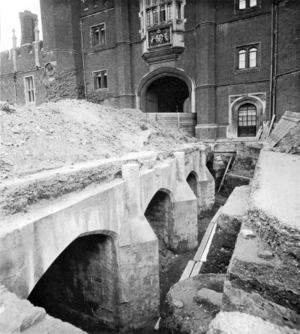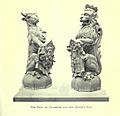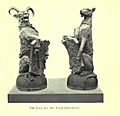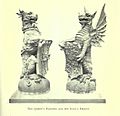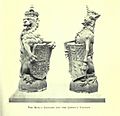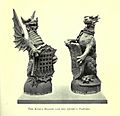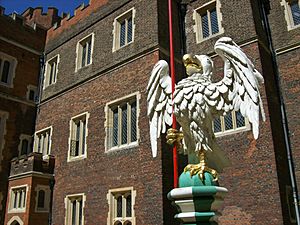King's Beasts, Hampton Court Palace facts for kids
The King's Beasts are 10 cool statues of animal symbols found on a bridge at Hampton Court Palace. These statues lead to the palace's main entrance. King Henry VIII ordered the first statues to show off his family history and that of his third wife, Jane Seymour. The original beasts were destroyed in the late 1600s. But new ones, looking just like the old designs, were put up in the early 1900s.
The animals are: the lion of England, the Seymour lion, the royal dragon, the black bull of Clarence, the yale of Beaufort, the white lion of Mortimer, the White Greyhound of Richmond, the Tudor dragon, the Seymour panther, and the Seymour unicorn.
Contents
History of the Royal Beasts
The bridge at Hampton Court Palace crosses a moat. The first bridge here was likely made of wood. But when Henry VIII took over the palace, he decided to build a new stone bridge. Work on this new bridge began in 1535.
By October 1536, the main part of the bridge was finished. Henry had just married Jane Seymour. So, he decided the bridge should celebrate their marriage. He ordered statues of the king's and queen's animals, each holding a shield. These statues were carved by Harry Corant and Richard Ridge from nearby Kingston. Each statue cost 26 shillings.
The bridge and its beasts stood for many years. But around 1691, during changes made by William III, the top part of the bridge and its decorations were taken down. They were even used to fill in the moat! The lower part of the bridge was covered with soil.
In 1909, the moat was finally cleared. The bridge was found in good shape, but most of the animal statues were gone. Only small pieces remained, like a dragon's wing or a unicorn's head. It was decided to rebuild the beasts based on the original plans and the pieces found. Edward Earle Dorling, an expert in symbols, led this rebuilding work.
Meet the King's Beasts
The King's Crowned Lion
This lion, wearing a crown, was a symbol for Henry VIII. It holds a shield that shows the royal symbols of England mixed with those of Jane Seymour.
The Seymour Panther
This panther is a symbol of Jane Seymour's family. It holds a shield with the Seymour family's coat of arms.
The Richmond Greyhound
The greyhound was a very popular animal symbol for the Tudor family. It was used by Henry VII and sometimes by Henry VIII. This greyhound has a leash, which is a bit unusual for royal animal symbols. Its name, "The Greyhound of Richmond," comes from its use by Henry VII's father.
The Beaufort Yale
A yale is a mythical creature. This one holds a shield with Jane Seymour's family symbols, given to her by her husband. The yale became a symbol for the Beaufort family, who were ancestors of Henry VII.
The Tudor Dragon
The Tudor dragon was a favorite symbol of the Tudors. It showed their Welsh family roots. This dragon holds a shield with the Beaufort family's portcullis badge. A portcullis is a strong gate, often seen at castles.
The Mortimer Panther
This is a second panther for the queen. It holds the same combined symbols as the king's lion.
The Clarence Black Bull
The black bull of Clarence holds a shield with a Tudor rose on it. The Tudor rose is a famous symbol of the Tudors. It combines the white rose of the House of York and the red rose of the House of Lancaster. This shows how these two families united when Elizabeth of York married Henry VII.
The Mortimer Lion
This lion wears a small crown and holds a shield with Jane Seymour's special symbol: a phoenix bird and a castle. It also includes a hawthorn bush, which refers to a Tudor story about Henry VII finding a crown in a hawthorn bush after a battle.
The Royal Dragon
This is a second royal dragon. It holds a shield with Henry's royal symbols.
The Seymour Unicorn
A unicorn holds a shield with the full symbols of Queen Jane Seymour. The unicorn is a symbol of purity and fertility. Some believe this symbol was chosen because Henry hoped his marriage would bring him the son he wanted so much.
Gallery
Other Royal Animal Statues
Other groups of King's or Queen's Beasts have been made, inspired by the ones at Hampton Court. For example, 42 royal animals sit on top of St George's Chapel, Windsor Castle. The original ones were from the 1500s, but new ones were put up in 1925.
A famous set of Queen's Beasts was created for the crowning of Queen Elizabeth II. These were very similar to the King's Beasts, but they had different animals to represent Elizabeth's family history.
In 2009, to celebrate 500 years since King Henry VIII became king, a new Tudor garden was made at Hampton Court. To decorate this garden, eight smaller wooden King's Beasts were carved from oak and painted in bright colors. Each one sits on a tall wooden column.


